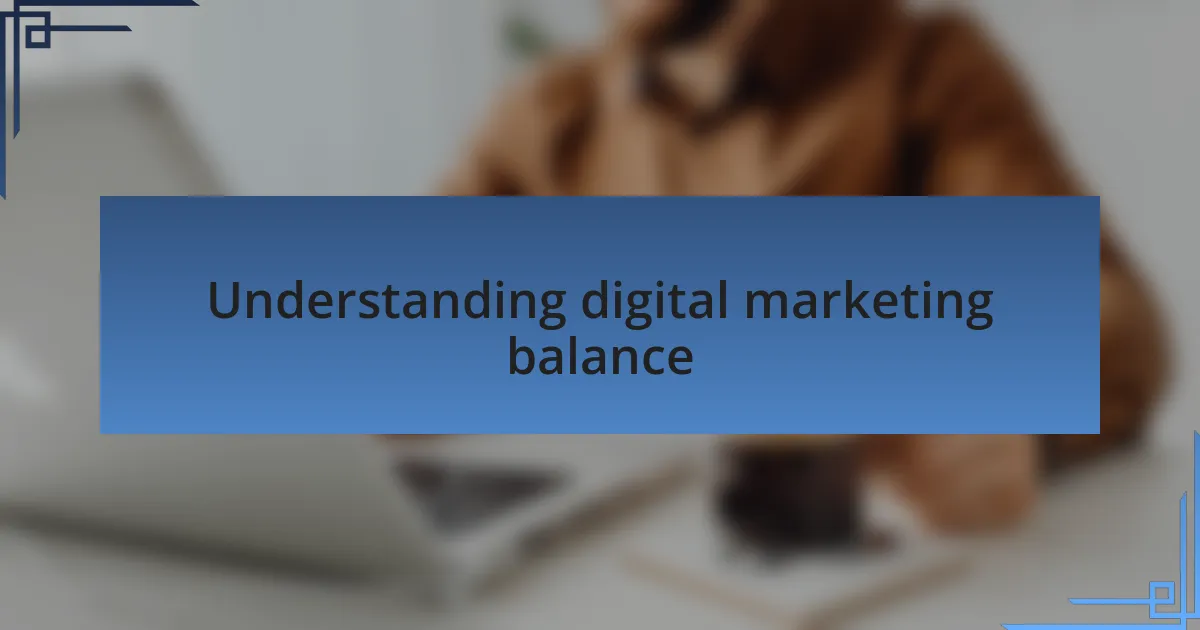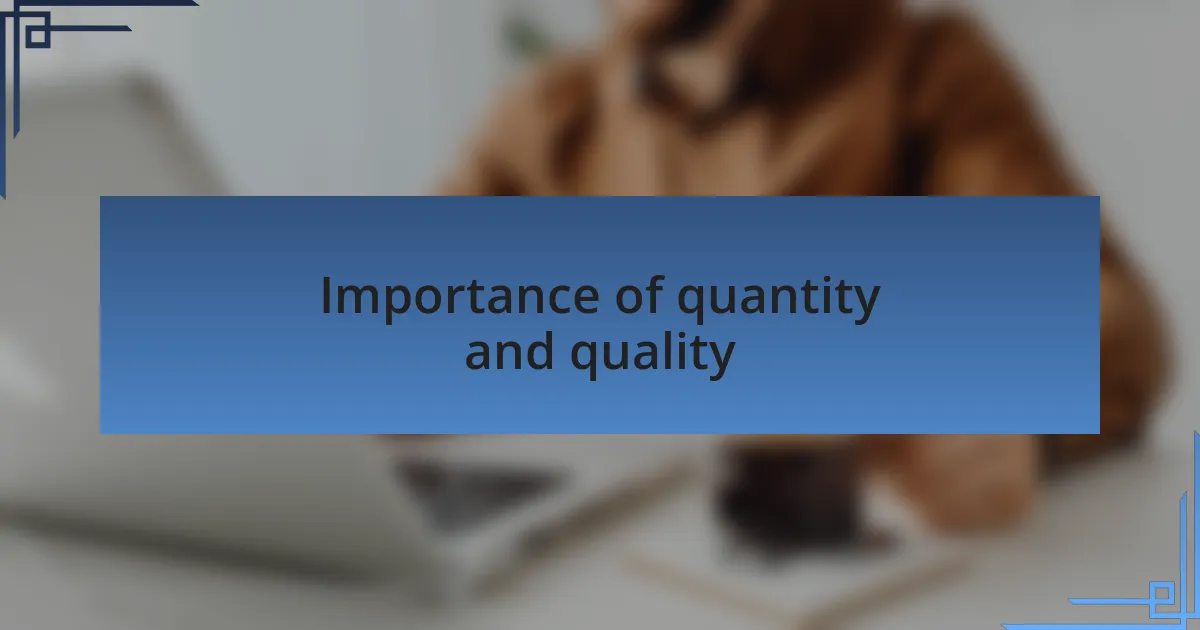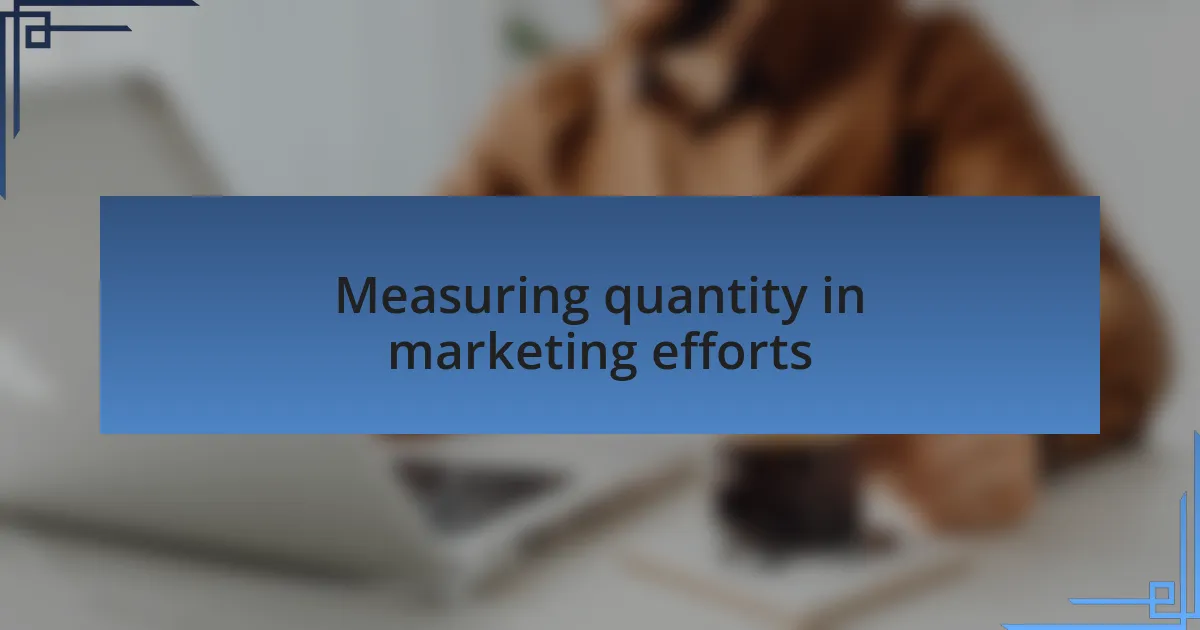Key takeaways:
- Finding a balance between quantity and quality in digital marketing is crucial for audience engagement and brand loyalty.
- Prioritizing high-quality content fosters meaningful connections and community building over merely focusing on high output.
- Utilizing strategies like content calendars and audience engagement helps maintain a harmonious balance between the amount and significance of content.
- Measuring quality through engagement rates and feedback is essential for refining marketing strategies and enhancing audience relationships.

Understanding digital marketing balance
Finding the right balance between quantity and quality in digital marketing is essential for success. I remember when I was starting out; I focused heavily on producing tons of content. At first, it felt productive, but soon I realized that the audience craved insightful, engaging posts over sheer volume.
It’s easy to get caught up in the metrics—impressions, clicks, shares. But have you ever noticed how a single impactful piece can generate more engagement than several mediocre ones? From my experience, when I shifted my focus towards crafting valuable content, the results were astonishing. The connection I built with my audience deepened.
Quality ensures that your messages resonate, while quantity can help extend your reach. However, it’s crucial to strike a harmonized rhythm where both elements coexist. There were moments when I had to ask myself—am I prioritizing the right aspects? Balancing them isn’t just a strategy; it becomes an ongoing conversation with your audience, constantly refining to meet their needs.

Importance of quantity and quality
Achieving the right blend of quantity and quality in digital marketing can significantly impact your brand’s presence. I learned firsthand that flooding social media feeds with posts might attract attention, but it’s the thoughtfully crafted messages that truly engage. Remember a time when you were scrolling through a sea of posts, only to pause at one that sparked an idea or emotion? That’s the power of quality.
When I began prioritizing quality content, I noticed a shift in how my audience interacted with my brand. For instance, one well-researched blog on a trending topic led to a lively discussion in the comments section, far more than a series of generic posts ever did. It struck me: why chase metrics that don’t foster real connection? This realization deepened my understanding of how meaningful content fosters a community.
While quantity can amplify visibility, it’s often quality that builds loyalty. As I navigated my journey, I often asked myself: what value am I providing? It’s this reflective approach that transformed my digital marketing efforts, allowing me to nurture trust with my audience. Balancing both elements not only enhances the effectiveness of your strategy but creates a space where genuine engagement flourishes.

Strategies for balancing content
When it comes to balancing content, a practical strategy I often employ is creating a content calendar. This becomes my roadmap, allowing me to plan both the volume and the depth of my posts. Have you ever felt overwhelmed by the sheer number of ideas swirling in your mind? Scheduling them out helps declutter those thoughts, making it easier to focus on crafting each piece with intent.
Another approach I find effective is repurposing high-quality content. I have taken a comprehensive blog and transformed it into a series of engaging social media posts, infographics, or even videos. It’s fascinating how one cornerstone piece can be reframed to reach different audience segments without sacrificing quality. Have you ever tried viewing your content from various angles to see what resonates? This not only extends the lifespan of valuable content but also ensures that I maintain quality while keeping the content pipeline flowing.
Lastly, I make it a point to engage with my audience actively. By asking them what types of content they find most valuable, I can tailor my strategy to align with their interests. Reflecting on my own experiences now, feedback has often led me to incredible breakthroughs. When you invite your audience into the conversation, how do you think it affects your content’s relevance? This interaction provides invaluable insights into what truly matters, allowing me to find a harmonious balance between quantity and quality that resonates with my community.

Measuring quantity in marketing efforts
When measuring the quantity of my marketing efforts, I closely monitor metrics such as the number of blog posts, social media updates, and email campaigns I generate each month. Keeping track of these figures helps me maintain an active online presence, which I’ve found is crucial for staying relevant. Have you ever tracked your output like this? It can be surprisingly motivating to see those numbers grow.
One aspect that stands out to me is the balance between sheer numbers and the impact they create. A few years ago, I committed to publishing daily social media posts, only to realize that it wasn’t just about quantity—it was about engagement. I noticed that when I reduced my posting frequency but focused on crafting high-quality, thought-provoking content, my audience interaction skyrocketed. It’s intriguing how a smaller, more intentional output can lead to better results.
I also utilize tools to analyze web traffic and conversion rates tied to my marketing efforts. It shocked me to discover that while I was churning out content, only a fraction was driving the desired engagement. This revelation pushed me to reevaluate my strategy: more isn’t always better. Have you ever found that the simplest tweaks can yield dramatic changes? By honing in on what truly resonates with my audience, I have been able to strike a satisfying balance between quantity and quality.

Measuring quality in marketing efforts
Measuring quality in marketing efforts involves more than just analyzing surface metrics; it requires digging into the nuances of audience engagement. I remember a campaign where the response was lukewarm at best. I was disheartened, but after deep diving into the data, I found that my audience craved more storytelling and less generic content. Has this ever happened to you? It’s revealing how understanding your audience’s preferences can reshape your strategy.
One key metric I focus on is the engagement rate rather than just likes or shares. During a particular project, I experimented with interactive content like polls and quizzes. Surprisingly, this shift resulted in a 40% increase in engagement, which taught me the importance of connection over sheer output. It reminded me that if my audience feels involved, they’re more likely to stay loyal and involved. What do you think makes your audience tick?
I also pay attention to feedback and sentiment analysis. Embracing constructive criticism can be tough, but it’s beneficial. I once received a detailed comment on my blog about clarity, which prompted me to refine my delivery. This adjustment not only improved my content’s quality but also fostered a genuine connection with my readers. Have you considered how feedback could elevate your efforts? Quality measurement is an ongoing journey that evolves with each interaction I have, guiding me to produce work that resonates at a deeper level.

Personal experiences in balancing
Balancing quantity and quality is a daily challenge that I navigate with intention. I recall a time when I pushed to publish a high volume of blog posts to increase visibility. It felt rewarding initially, but my audience’s engagement declined sharply. This experience taught me that focusing solely on quantity can dilute the value provided, leading to a disconnection that’s hard to recover from.
In another instance, I chose to slow down and invest more time in fewer pieces of content. One blog post, in particular, stemmed from deep research and careful crafting. The positive feedback it received reignited my passion for quality, reminding me that sometimes, less truly is more. Have you ever noticed how much more impactful a well-thought-out piece can be compared to something rushed?
This balancing act often feels like walking a tightrope; every step requires mindfulness. I’ve learned to prioritize quality by ensuring I allocate the necessary time for creativity and refinement, even if it means cutting back on the number of projects. It’s rewarding to see how this approach not only enhances my work but also fosters deeper relationships with my audience. Does striving for that balance resonate with your experiences?